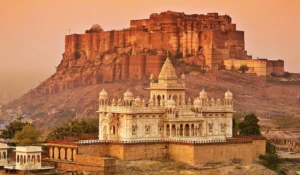
Table of Contents
Jodhpur : Best Place To Visit
 Jodhpur, also known as the Blue City due to the distinctive blue-painted houses in its old city area, is a vibrant and historically rich city located in the Rajasthan state of India. It is the second-largest city in Rajasthan and is known for its majestic forts, palaces, temples, and unique cultural heritage.
Jodhpur, also known as the Blue City due to the distinctive blue-painted houses in its old city area, is a vibrant and historically rich city located in the Rajasthan state of India. It is the second-largest city in Rajasthan and is known for its majestic forts, palaces, temples, and unique cultural heritage.
Key Highlights and Attractions
-
 Mehrangarh Fort:
Mehrangarh Fort:- One of the largest and most impressive forts in India, Mehrangarh Fort stands tall over the city, offering a panoramic view of Jodhpur.
- Built in the 15th century by Rao Jodha, the fort houses a museum that showcases artifacts, weapons, and royal belongings from the Marwar dynasty.
- The fort’s architecture and intricate carvings are awe-inspiring.
-
Umaid Bhawan Palace:
- A magnificent palace built in the early 20th century, the Umaid Bhawan Palace is a blend of Indian and Western architectural styles.
- Part of the palace is still used by the royal family, while the rest has been converted into a luxury hotel and museum.
- The museum in the palace offers insights into the history and royal heritage of Jodhpur.
-
Clock Tower and Sardar Market:
- The Clock Tower is a prominent landmark in Jodhpur, surrounded by the bustling Sardar Market, where visitors can shop for spices, textiles, handicrafts, and traditional Rajasthani items.
- The market is vibrant with colorful bazaars and street food, offering a taste of the local culture.
-
Jaswant Thada:
- A beautiful marble cenotaph built in memory of Maharaja Jaswant Singh II, located near Mehrangarh Fort.
- The cenotaph features intricate carvings and offers a peaceful environment with stunning views of the fort and surrounding landscapes.
-
Mandore Gardens:
- Mandore is home to a complex of temples, cenotaphs, and gardens that were once the seat of the Marwar rulers before Jodhpur.
- The architecture and lush greenery make it a great spot for history lovers and nature enthusiasts alike.
-
Balsamand Lake:
- A serene and picturesque lake located about 5 kilometers from the city center. It is an ideal spot for picnics, boating, and enjoying the natural beauty of the region.
-
Kaylana Lake:
- Another scenic lake located on the western side of Jodhpur, offering boating opportunities and a beautiful landscape to unwind.
- It is a popular place for bird watching as well.
-
Mandore Fort:
- Mandore Fort is an ancient fort complex located on the outskirts of Jodhpur. It contains temples, cenotaphs, and gardens, showcasing the historical importance of the region.
Culture and Cuisine:
Jodhpur’s culture reflects the vibrant traditions of Rajasthan. The city is known for its folk music, dance, and handicrafts such as bandhej (tie-dye), blue pottery, and traditional textiles. Jodhpur is also famous for its Rajasthani cuisine, including dishes like dal baati churma, gatte ki sabzi, and ker sangri.
Climate:
Jodhpur has a hot desert climate with very hot summers, mild winters, and minimal rainfall. The best time to visit Jodhpur is from October to March when the weather is pleasant for sightseeing.
Transportation:
- Air: Jodhpur has an international airport, Jodhpur Airport, which is well-connected to major cities in India.
- Train: The city is well-connected by train to cities like Jaipur, Delhi, and Mumbai.
- Road: Jodhpur is well-connected by roads, with regular bus services from neighboring cities and states.
History
Jodhpur has a rich and fascinating history that dates back to the 15th century. Located in the Thar Desert of Rajasthan, it is known for its iconic forts, palaces, and vibrant culture. Here’s an overview of the history of Jodhpur:
 Founding of Jodhpur:
Founding of Jodhpur:
Jodhpur was founded in 1459 by Rao Jodha, a chief of the Rajput clan. Rao Jodha belonged to the Marwar region and was a descendant of the Chauhans of Ajmer. The city was established after he shifted his capital from the old town of Mandore (which was vulnerable to attacks) to a more secure location on a hill. The location chosen was strategic as it provided a strong defense and a commanding view of the surrounding region.
Establishment of Mehrangarh Fort:
- The most prominent landmark in Jodhpur is the Mehrangarh Fort, which was constructed by Rao Jodha in 1460, just after founding the city. The fort sits atop a hill and is one of the largest and most impressive forts in India.
- Mehrangarh became the seat of the Marwar dynasty, which ruled over the region for centuries. It was expanded and fortified over time, with numerous additions by different rulers of Jodhpur.
- The fort housed palaces, temples, and the royal residence. It also contained weapons, armor, and artifacts related to the royal family. The fort’s architecture is an excellent example of Rajput and Mughal styles, blending the grandeur of both cultures.
Rise of Marwar:
- Jodhpur and the Marwar region became an important political and military power under the rule of the Marwar Rajputs. The region was often engaged in conflicts with neighboring states, including the Mughals, the Mewar dynasty, and other Rajput rulers.
- Over the centuries, Marwar’s influence grew, and Jodhpur became a key center for trade, culture, and military power in Rajasthan.
The Mughal Period:
- In the early 17th century, Emperor Akbar of the Mughal Empire took control of much of Rajasthan. During his reign, Jodhpur was part of the Mughal dominion, but the Marwar Rajputs were allowed to retain control over their kingdom.
- Maharaja Jaswant Singh I, a prominent ruler of Jodhpur, became an ally of the Mughals, though he later broke ties with the Mughal Empire after the death of Emperor Aurangzeb. His efforts to maintain Marwar’s autonomy and control over the region were significant in the history of Jodhpur.
 The 18th and 19th Century:
The 18th and 19th Century:
- The 18th century was marked by conflicts with the Mewar rulers, as well as challenges from the expanding Maratha Empire. The city and its rulers experienced a mix of alliances, wars, and political maneuvering.
- In the 19th century, Jodhpur became a princely state under the British Raj. The state was part of the Rajputana Agency and played a significant role in the political structure of Rajasthan.
- During British rule, Jodhpur became a prosperous region due to its trade routes and the establishment of industries like textile manufacturing.
Jodhpur After Indian Independence:
- With India’s independence in 1947, Jodhpur, like other princely states, merged into the newly-formed Indian Union.
- The princely state of Jodhpur was integrated into the state of Rajasthan after independence, and the rulers of Jodhpur gradually relinquished their political powers.
Modern Jodhpur:
- Today, Jodhpur is a vibrant and bustling city that is both a historical center and a hub of modern development. It is known for its tourism, as it attracts visitors from around the world with its stunning palaces, forts, and unique cultural heritage.
- Jodhpur is often called the “Blue City” due to the blue-painted houses in the old city, a tradition that dates back centuries and is thought to have originated with Brahmins (who painted their homes blue to signify their caste).
Best Places To Visit In Jodhpur
- Meharangarth Fort
- Jaswant Thada
- Toorji’s steps well
- Phool Mahal
Mehrangarh Fort
Jodhpur is a city in the Thar Desert of the northwest Indian state of Rajasthan. Its 15th-century Mehrangarh Fort is a former palace that’s now a museum, displaying weapons, paintings, and elaborate thus royal palanquins (sedan chairs).
Set on a rocky outcrop, the fort overlooks the walled city, where many buildings are painted the city’s iconic shade of blue. therefore Explore the Jodhpur holidays and discover the best time and places to visit
Jaswant Thada
Jaswant Thada is also called Tajmahal of Jodhpur. This place exhibits exquisite architecture made of marble and the famous reddish-pink Jodhpur sandstone. While The best time to visit this place is in the morning. Therefore The place is the royal cremation ground for the erstwhile royal family.
It is a place of absolute peace. thise Walking around the mausoleum surrounded by a lake and rocky structure is a wonderful experience.
This is surrounded by a well-maintained garden. The place is kept so clean that one will feel like removing shoes to roam around the premises.
Of course, one has to remove shoes to enter the main mausoleum. Also, the vista from the top overlooking the old Jodhpur city is magnificent To the right the mighty Mehrangarh fort stands tall.
Toorji Ka Jhalra (Toorji’s Step Well)
The Step Well Square is a mini-architectural tour with Toorji’s Step Well at the center, and almost 250 yrs of building tradition on view. Built-in the 1740s, submerged for decades, its recent restoration uncovered over 200 hundred feet of hand-carved treasure.
Spend a few hours exploring this architectural wonder, and lunch, dine, and sip, thus shopping at the many restaurants and shops in the square.
Phool Mahal
As the name suggests it’s glasswork that the kings used to visit to have recreation & fresh air. While You will find this particular section in every fort of Rajasthan. It is located inside the Mehrangarh fort of Jodhpur
You will love the vibrant colors at this particular place
The mirror art here is a mesmerizing
Best Places To Visit In Jodhpur
Looking for a super exciting trip with your friends this session? However, your search ends at one of the most vibrant states Jaisammer and jodhpur with my friends and if you love to travel and explore then you must visit these places.
Both these cities are amazing in their respective manners but the fun doubles when you have the company of your friends.
IF YOU LIKE READING THIS ARTICLE,
DO CHECK THIS ARTICLE TOO,
